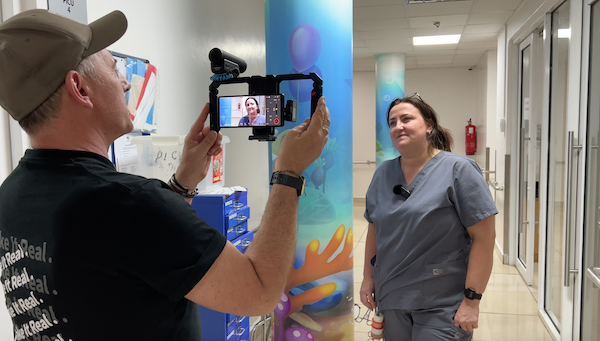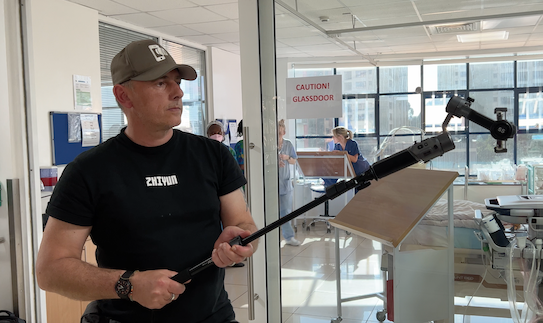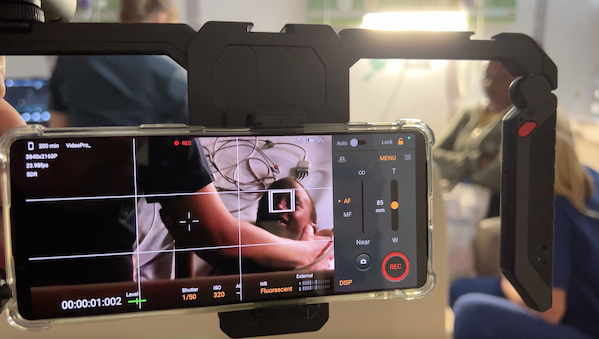
Mobile cinematographer Cassius Rayner filming in a Kenyan hospital using smartphone equipment
Credit: Cassius RaynerCassius Rayner is a multi-award-winning filmmaker and mobile cinematographer. He has more than two decades of industry experience as a camera operator and director, and nine years exclusively shooting with mobile phones. He has a YouTube channel full of mobile journalism tricks, techniques and demos.
Four years ago, Dr Salim approached me after hearing that I had shot a documentary called Heart Warriors in Ethiopia using a smartphone.
He explained the extraordinary work his charity was, and is, doing in developing countries. Every penny donated is used to send consultants, specialist nurses and surgeons to countries where help is needed in saving children's lives and training local medical teams in how to advance themselves.
So there was no budget for filming. The cost from my end would be low compared to a mainstream video company but it would still need a budget to cover all the costs.
I was not able to help at that time but we stayed in touch and he kept me posted about various missions they were doing. Over time, I kept sending proposals for funding to various companies that would take months and months to get back to me. The opportunity came up again to join Healing Little Hearts but the clock was against me, but this time Sony and Filmic Pro agreed to come on board with some funding.
It was enough for me to commit, and then work out how to raise the remaining fund needed for post-production on my return. In May 2023, I joined the medical team of 24 volunteers at the airport and we flew to Nairobi, Kenya.
The next 10 days were spent documenting and following the teams as they operated on children. It was exhilarating, emotional, exhausting and deeply sad as well. I was privileged to have full access to everything they were doing, no restrictions and with a mobile I was able to move quickly and not interfere with their work.
Access, intimacy and subtlety
My mission was to really capture the moments, no pre-set-up interviews with the team, children or families.
I wanted the audience to feel and see what I was feeling. I captured interviews whilst they were working, so it was immediate and emotional.
Shooting with the smartphone enabled me to film like this, without being intrusive or interrupting the important work happening in the hospital.
I gained their trust quickly as they understood how I was working and many of them were relieved that I was not going to do any formal interview set-ups.
Using wireless mics, I was able to leave these on the doctors and then be able to capture the really important moments with clear audio.
They also would forget the mics were on them, this freed me to shoot in a variety of ways without having to stop them from their work. The team was spread out on various wards in different parts of the building, and again I was able to move quickly and shoot very quickly.
The set-up
Mobile device: Sony Xperia pro-1 and 1 mark4
Through previous experience overseas filming using the iPhone, I still had to develop various workflows to get around the noise issues that occur in low light.
I did a variety of night shoots using the Sony Xperia and was genuinely amazed at its capability in low light - using the video pro app I was able to use the ISO at levels I had never been able to do before using an iPhone.
Another factor was the Xperia being able to shoot 4k at 120fps. Again, this is something I use a lot as through experience on previous projects the only way to capture the environment, streets, people and buildings is to use slow motion.
Finally, the AI focusing is very good on the Xperia and being able to switch from manual focus to AI focusing was also key.
I had a couple of video lights with me, but after shooting on the first day I felt the natural light was the best method and again not wanting to stop the flow of what was unfolding.

Cassius Rayner
Fulaim wireless mic kit + Sennheiser MKE 400 mic
This allowed me to mic two people with stereo sound, and gain more natural audio recording and wild tracks.
SmallRig foldable handheld rig
Compact, sturdy and very quick to use. When not being used it would fold up into my pocket.
Zhiyun smooth 5s gimbal
It can take the weight of the mobile and additional ND filters with a filter adapter as I knew I would be using it a lot.

Cassius Rayner
My main plan with filming documentaries is to make sure that everything I need is attached to my belt, fits in my cargo pockets and can grip bags that are attached to my belt. I need to work fast, grab what I need and the smartphone is key to this.
Intended outcomes
Having spent 10 days, 15 hours a day watching and documenting what the team was doing was beyond words. The visual content, stories and moments I have captured will be very important content for Healing Little Hearts to show the work they do, why they do it, and why people should help.
A smartphone was the best tool I could use to document this experience. I was able to shoot angles and move into spaces not possible with bigger cameras.
What is also interesting for me as a filmmaker is that my relationship with those that I film becomes very close - sometimes emotional - because I sense when they are drained, exhausted and trying to keep going.
A smartphone helps me gain the trust of those that I am feeling, because they know it is for the greater good and not a commercial project. In my previous 20 years of production, the experience of filming with a smartphone is unlike anything else.

Cassius Rayner
As of right now, I am still trying to raise the remaining funds to deliver all the stories and content to Healing Little Hearts so that they can use it to support their ongoing missions. I am also thinking about returning to do a follow-up project in November when the team goes back, for which I will have to seek additional funding.
More with Cassius Rayner:
Parting thoughts
I have been filming with smartphones since 2014, because I could see the benefits creatively and financially not only for aspiring filmmakers, but for charities, NGO's and educational organisations.
I have been fortunate in training disadvantaged and marginalised people so that they have a voice and the technology in their pockets to tell their stories. Smartphones empower people globally for the greater good.
Charities are suffering and shutting down every day due to the present economic situation globally. They cannot afford professional video content. But they also are not aware that a professional filmmaker with a smartphone can capture everything an organisation needs at a fraction of the cost.
There should also be national and global training for charities in mobile journalism that gives them the skills and knowledge to continue documenting important stories. It only takes one global company to recognise the importance of this.
Free daily newsletter
If you like our news and feature articles, you can sign up to receive our free daily (Mon-Fri) email newsletter (mobile friendly).
Related articles
- 40 essential newsletters every journalist should read
- New project InOldNews wants to improve representation in video journalism
- 38 mojo apps from BBC trainer Marc Blank-Settle
- 15 online communities for journalists you should know about
- Ukrainian journalists use smartphones to tell stories of displaced communities









